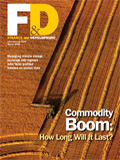 About F&D Subscribe Back Issues Write Us Copyright Information Free Email Notification Receive emails when we post new
items of interest to you. |
In Brief Establishing a sound debt strategy can help immunize a country against sudden, adverse market changes and financial turmoil. To help analyze the soundness of a country's public debt management, the IMF has developed tools that can be used by IMF teams and country authorities to measure the risks of emerging market public debt. By using these new assessment tools, public debt managers can become more aware of the impact on their debt obligations of changes in financial and economic circumstances and be in a better position to develop policy responses quickly to address such changes. These tools can also help them minimize the difficulties of managing public debt. Measuring the risks of public debt is a critical first step in managing debt. A key benefit from this step is the reduction of vulnerabilities, including to international financial shocks. Smaller and emerging market countries are more vulnerable to such shocks because their economies are less diversified, have a smaller base of domestic financial savings and less developed financial systems, and are more susceptible to financial contagion. The Risk Measures framework—which includes two Excel-based templates—offers estimates of a country's public debt riskiness relative to that of other countries at a similar level of development. It also provides an indication of a country's credit rating, access to international capital markets, and prospects for the placement of its debt with international investors. The templates allow the calculation of a number of measures, both conventional and new. Among these are indicators that capture interest rate and exchange rate risks (duration, convexity, and value at risk, or VAR), credit risk (contingent claims approach), and liquidity risk arising from a possible lack of sufficient tradability in government debt market instruments. For information on how to obtain a copy of the Risk Measures templates, contact Marcos Souto (msouto@imf.org) or Michael Papaioannou (mpapaioannou@imf.org). Coral reef experts and supporters have designated 2008 the International Year of the Reef, calling for greater efforts to combat climate change to protect the world's biologically complex ocean ecosystem. Scientists estimate the world has already lost 30 percent of its coral reefs, mostly from the effects of overfishing, nutrient pollution, and habitat conversion, but coral bleaching and increasingly acidic seas—both associated with climate change—are exacerbating these effects and pushing many coral reefs over the edge. Research by 17 scientists, published in the December 14, 2007, issue of Science, suggests the tipping point for coral reefs would be CO2 concentrations of 450 parts per million (ppm) in the atmosphere. CO2 levels are currently about 380 ppm. "There is a narrow window to act," says Marea E. Hatziolos, World Bank Senior Coastal and Marine Specialist and a coauthor of the Science paper. "Coral reefs as we know them will be gone by 2050 if steps are not taken now to drastically reduce CO2 emissions." The world has lost about 3.6 million hectares of mangroves since 1980, equivalent to an alarming 20 percent loss of the total mangrove area, according to the UN Food and Agriculture Organization's (FAO) recent mangrove assessment study. Asia has suffered the largest net loss of mangroves since 1980, with more than 1.9 million hectares destroyed, mainly because of changes in land use. The FAO cited high population pressure, the large-scale conversion of mangrove areas for shrimp and fish farming, agriculture, infrastructure, and tourism, as well as pollution and natural disasters, as the major causes of the destruction of mangroves. Mangroves— salt-tolerant evergreen forests found along coastlines, lagoons, rivers, and deltas—are important ecosystems providing wood, food, fodder, medicine, and honey. They are also habitats for animals such as crocodiles, snakes, tigers, deer, otters, dolphins, and birds. Australia, Brazil, Indonesia, Mexico, and Nigeria together account for about 50 percent of the total global mangrove area. Some 250,000 children worldwide are being recruited to fight in armed conflicts in violation of international law, the UN said in its latest report on children and armed conflict, which covers October 2006 to August 2007. Children are being recruited by groups in Afghanistan, Burundi, Chad, the Central African Republic, Colombia, the Democratic Republic of the Congo, Myanmar, Nepal, the Philippines, Somalia, Sudan, Sri Lanka, and Uganda. On the positive side, the report says, no new cases of child recruitment have been reported in Côte d'Ivoire. And Sierra Leone and Liberia, both of which used to have child soldiers, also no longer appear on the report's "list of shame." In 2007, global foreign direct investment (FDI) reached a new high of $1.5 trillion, the UN Conference on Trade and Development (UNCTAD) reported. The UN agency attributed the record high to the growth of transnational corporations and strong economic performance in many parts of the world. Despite the financial and credit crisis that began in the latter half of 2007, the overall level of FDI was not affected. Last year FDI flows to developed countries grew for the fourth year in a row, to $1 trillion, with the United States retaining its spot as the largest single recipient. The European Union as a whole continued to be the largest host region, attracting almost 40 percent of FDI flows in 2007. FDI flows to developing countries and transition economies not only rose last year—by 16 percent and 41 percent, respectively—but also reached record-high levels. In Africa, investment remained relatively strong last year, when an unprecedented level of inflows ($36 billion) was supported by a continuing boom in global commodity markets. The outlook for 2008, however, is more modest. Continuing global external imbalances, sharp exchange rate fluctuations, rising interest rates, and increasing inflationary pressures, as well as high and volatile commodity prices, pose risks that may have a chilling effect on global FDI flows, UNCTAD warned. May 17–19, Sharm El Sheikh, Egypt May 18–19, Kiev, Ukraine June 3–4, Paris, France June 5, Wellington, New Zealand July 7–9, Hokkaido, Japan
|